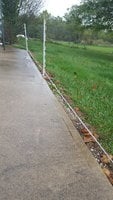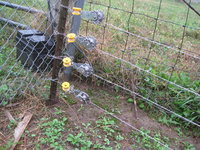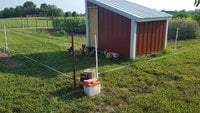He has to get out again too, and anything he (it) climbs over will hit the top hot wire.If he jumped from a tree, it wouldn't zap him?
Navigation
Install the app
How to install the app on iOS
Follow along with the video below to see how to install our site as a web app on your home screen.
Note: This feature may not be available in some browsers.
More options
You are using an out of date browser. It may not display this or other websites correctly.
You should upgrade or use an alternative browser.
You should upgrade or use an alternative browser.
A treatise on Electric Fencing
- Thread starter Howard E
- Start date
well the poultry net is off because of the snow and there was coyote tracks in one poultry yard Tuesday morning. It jumped the 4' net near my house and looked around some areas with lots of cover. The closest it got was 3-4ft to the main coop. I think it was looking for rodents, no sign that it got any. it then went over to the other side which has a 6' field fence, the top 18" is floppy. It tried to go over but fell back in. it then paced that fence line and went over the corner that wasn't floppy and got out. A larger set of tracks was around the poultry yard perimeter. They left together.
This morning tracks by the house and out to the field but not in the poultry yard.
This morning tracks by the house and out to the field but not in the poultry yard.
I am having Red Fox operating with total disregard to my hotwire. The hotwire has not be hot since Friday after noon. That is where it pays to have a backup plan. Other system components are up. When snow finally goes down the fox will get surprised and not come. Fox coming in, based on tracks, is running about a lot. My opinion is the abundant rabbits are the draw, not the chickens.
I know this was posted several years ago but I’m a new member. I just wanted to thank the author for the thorough explanation. I want to set up a mobile area that I can rotate on our acreage as needed. The cost of electric poultry netting is prohibitive so I am going to give the two strand method a try. Thank you so much for the comprehensive information.
Keep on peepin’ on,
Misti
Keep on peepin’ on,
Misti

 This is all great information. I personally use the poly rope wire. There have been times when I have forgotten to turn it off and have touched the wire and it has made my heart skip a few beats. I have a 25 mile AC fence charger at 1 joule. My current usually runs around 9000 volts. There are sections where I have 3 wires and behind the coops one or two wires. The predators know it's there. I have heard critters test it especially when I first put it up. I have had it for many years. I have a 6' ground rod near my charger. My charger is on the outside of one of the coops under the eve. It's been working fine. I have another charger inside my chick/grow-out coop.
This is all great information. I personally use the poly rope wire. There have been times when I have forgotten to turn it off and have touched the wire and it has made my heart skip a few beats. I have a 25 mile AC fence charger at 1 joule. My current usually runs around 9000 volts. There are sections where I have 3 wires and behind the coops one or two wires. The predators know it's there. I have heard critters test it especially when I first put it up. I have had it for many years. I have a 6' ground rod near my charger. My charger is on the outside of one of the coops under the eve. It's been working fine. I have another charger inside my chick/grow-out coop.- Thread starter
- #96
I know this was posted several years ago but I’m a new member. I just wanted to thank the author for the thorough explanation. I want to set up a mobile area that I can rotate on our acreage as needed. The cost of electric poultry netting is prohibitive so I am going to give the two strand method a try. Thank you so much for the comprehensive information.
Keep on peepin’ on,
Misti
You are welcome. That information was put together and left in hopes that you (and others like you) would find it.
If this is to be a long term (year or more) or permanent fence, I'd use 17 gauge aluminum wire. It's more durable. If this is to be a temp fence that you will be moving around, I would suggest you use either poly tape or poly rope for your fence strands. Just as effective and easier to work with. This assumes small area of 1 acre or less. The "poly" wires can be tensioned and stretched by hand. Wire wire requires the use of mechanical strainers to do the tighten up. With any of these fences, use the inexpensive poly step in posts, which have really good spacing to support the wires for our use.
I've built several of these fences and the method that has worked best for me is to start with only one strand. The bottom one. Turn the birds and to train them. They will walk up to and step on (or perhaps hop over) this bottom strand. But in short order, they will all find it. Either by stepping on it, trying to crawl under it, etc. It will get them. Once zapped, few of them will cross it again. The one I use to keep my trained birds off the patio is this......

The same birds that think nothing of flying over the chain link fence in the background will not cross this single strand. (BTW, those are the posts to use). This assumes you have offered them enough room and cover within the enclosure they do not feel compelled to escape. I doubt you could keep a dozen birds in a 10' x 10' enclosure of bare dirt and mud if there was something green just on the other side, but 100' x 100' with cover? It will do that.
Once the birds are trained, which should take only a day or so, then start adding strands for varmints. Two should suffice for most of them, but 3 or 4 is better for things like dogs. This photo shows wires, but the spacing is the same. Use the bottom 3 or 4 clips on the step in posts and it will come our right.

Biggest mistake most folks make with these is to think these work like a physical fence. It does not. Goal is to get varmint to simply make contact with the fence. Spacing of the strands is designed to get them to touch it. Probably 99% of them will attempt to crawl under or through it and get themselves zapped in the process. Goal is to get them zapped. Once zapped, fence location becomes a barrier zone they will not cross.
Second biggest mistake is to go cheap on the charger. Get a 1 joule minimum.....a fence rated for 25 miles plus, even if you only plan to use a few hundred feet. You want this to be the worst "near death" experience these animals have ever experienced.......something they will never risk a repeat of.
Hope this helps!!!
Attachments
You are welcome. That information was put together and left in hopes that you (and others like you) would find it.
***
It is very kind of you to reply with additional information. We do have dogs, as well as feral barn cats, that we are concerned about. Setting up moveable 100 x 100 paddocks would be great. We have five acres to rotate them around on but I want to keep them where I can easily see them until I know that they are relatively safe from the other animals that reside here. This helps immensely!
You are appreciated!
Misti
Hi. Is there any other way to train them to the fence? Mine already has all 3 strands of wire up. They walk right through it. Is there a good kind of bait to lure the chickens to touch the wire? The thought of dismantling the top two rows and redoing them is a very daunting idea for me.I've built several of these fences and the method that has worked best for me is to start with only one strand. The bottom one.
- Thread starter
- #99
Hi. Is there any other way to train them to the fence? Mine already has all 3 strands of wire up. They walk right through it. Is there a good kind of bait to lure the chickens to touch the wire? The thought of dismantling the top two rows and redoing them is a very daunting idea for me.
How far apart are your wire strands? Bottom strand from the ground and each strand from each other. (Post a picture of your setup if possible)
What fencer are you using and have you tested it for line voltage?
If I wanted to bait it so the chickens would learn, I'd scatter grain under and just beyond. Oats, sunflower seeds, whole corn, etc. Just about the right place so when they raised their heads, their comb would touch the bottom wire.
Oh, that's a good idea about the grain!How far apart are your wire strands? Bottom strand from the ground and each strand from each other. (Post a picture of your setup if possible)
What fencer are you using and have you tested it for line voltage?
If I wanted to bait it so the chickens would learn, I'd scatter grain under and just beyond. Oats, sunflower seeds, whole corn, etc. Just about the right place so when they raised their heads, their comb would touch the bottom wire.
The bottom wire is on the lowest level of the white step in posts. The next one is the next level up, not counting that they seem to have two hooks right near each other. And then the third wire is spaced a little further. I do think I have a photo...
I have the 5 mile solar charger from TSC. The tester says it is putting out about 6.9 kilovolts near the charger, about 6.8 part way around, and 6.7 at the farthest distance away (half way across). Until I am convinced otherwise, I'd like to believe the tester and not touch it myself.
 DH is in favor of me videotaping myself touching it.
DH is in favor of me videotaping myself touching it. 
An update since yesterday morning: When I went out in the evening to observe, most of the birds were on the correct side of the fence. A group of ducks was separated from their friends, which told me they didn't want to cross the fence to go back in.
 AND, when I opened the gate to try to herd them in, they were not willing to go through the gate or near the fence. It took a lot of running back and forth before I got some to go in, and the last one just panicked and stumbled through the wire. I do believe the ducks are now trained.
AND, when I opened the gate to try to herd them in, they were not willing to go through the gate or near the fence. It took a lot of running back and forth before I got some to go in, and the last one just panicked and stumbled through the wire. I do believe the ducks are now trained. Today most of the chickens seem to be staying inside the fence. Upon opening the coop this morning, 3 went right through the wire, but much slower than yesterday. Their friends did not follow, and after a bit, the 3 were back in. So I think that most of them respect the fence now.
When (if I need to) I try the grain thing, I will just do a few individual pieces. Once they get zapped, I don't want to leave frustrating temptation just out of their reach.
This photo is just the gate I made. It's wire is somewhat looser than the body of the fence. And I'm waiting for a good rain so I can step the posts into the ground further.
New posts New threads Active threads
-
Latest threads
-
Found rat poop in chicken feed - how long do we need to refrain from eating eggs?
- Started by thewhimsicalflock
- Replies: 0
-
4yo hen lethargic and sticky mouth
- Started by beachbunny76
- Replies: 0
-
Bumblefoot healing process [pics]
- Started by Chickenlady1234567
- Replies: 0
-
Sapphire Gem Cockerel or Pullet please!
- Started by NewYorkMama
- Replies: 2
-
Giving away coop design
- Started by TheChickenChaser
- Replies: 1
-
-
Threads with more replies in the last 15 days
-
-
-
-
Open Contest BYC's 4th of July Star Spangled Hatch-Along—Stars, Stripes, & Feathers, a Text-to-Image Contest
- Started by Debbie292d
- Replies: 82
-
-





